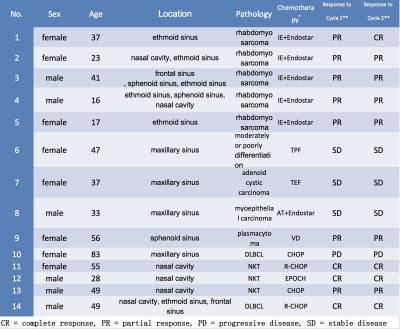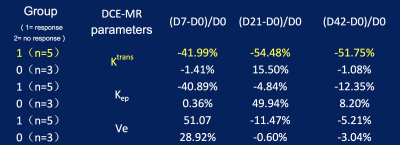1967
Quantitative Dynamic Contrast Enhancement MR Imaging Parameters in the Prediction and Evaluation of the Treatment Response of Malignant Sinonasal Tumors to Chemotherapy1Department of Radiology, Beijing Tongren Hospital, Capital Medical University, Beijing, China, 2GE Healthcare, China, Beijing, China
Synopsis
This work assessed the feasibility of quantitative parameters derived from quantitative dynamic contrast enhancement MR imaging (DCE-MRI) parameters in the prediction and evaluation of the response to chemotherapy in patients with malignant sinonasal tumors.
Purpose
Quantitative Dynamic contrast enhanced MRI (DCE-MRI) parameters derived from pharmacokinetic modeling provided an effective method of evaluation of blood flow and microcirculation. The aim of the study to investigate the value of quantitative dynamic contrast enhancement MR imaging (DCE-MRI) parameters in the prediction and evaluation of the response to chemotherapy in patients with malignant sinonasal tumors by comparing the parameter values on the 7th, 21st and 42nd days after chemotherapy.Methods
This study was obtained the situational Ethics Committee Approval and informed consent was waived. DCE-MRI using a 3.0T MR scanner (GE Signa HDxt scanner with an 8-channel phased array head coil) was taken in 14 (Table.1) patients with malignant sinonasal tumors before chemotherapy, in which DCE-MRI was performed in 8 patients on the 7th, 21st and 42nd days after chemotherapy. The region-of-interest (ROI) was selected based on diffusion weighted imaging, avoiding the area of cystic and necrosis. Using the two-compartmental model, quantitative parameters including Ktrans, kep and ve were calculated. Two radiologists reviewed these maps and measured Ktrans, kep and ve in the tumor tissue. Rank test analysis was used to compare the Ktrans, kep and ve values of the tumor with malignant sinonasal tumors between the response group with no response group before chemotherapy. SPSS22.0 statistical software. The P value less than 0.05 was considered to represent a significant difference. The change rate of these quantitative parameter values after chemotherapy was also calculated.Results
Response to chemotherapy of the tumor was found in 11 patients with malignant sinonasal tumors, whereas no response to chemotherapy of the tumor was confirmed in 3 patients. Ktrans and kep values of the tumor before chemotherapy in patients with response to chemotherapy were significantly bigger than those in patients with no response to chemotherapy (p<0.01). There was no significant difference in Ve values between two groups (p>0.01) (Table.2). Compared with Ktrans values of the tumor before chemotherapy, the change rate of Ktrans values decreased more than 40% on the 7th, 21st and 42nd days after chemotherapy in five patients with treatment response, whereas the change rate did not decrease significantly in three patients without treatment response (Table.3, Figure.1).Conclusion
DCE quantitative parameters may be a promising imaging biomarker of tumor prognosis. The bigger Ktrans and kep values of the tumor before chemotherapy, the better the treatment response of the tumor to chemotherapy. More patients are needed to verify that Ktrans and kep values of the tumor might be potentially useful in the prediction and evaluation of treatment response to chemotherapy of malignant sinonasal tumors.Acknowledgements
No acknowledgement found.References
[1] Maroun J A, et al. National Cancer Institute of Canada[J]. Canadian Medical Association Journal, 1947, 56(3):533.
[2] Fangberget A, et al. Neoadjuvant chemotherapy in breast cancer-response evaluation and prediction of response to treatment using dynamic contrast-enhanced and diffusion-weighted MR imaging[J]. European Radiology, 2011, 21(6):1188-99.
[3] Chen X, et al. Role of periodically rotated overlapping parallel lines with enhanced reconstruction diffusion-weighted imaging in correcting distortion and evaluating head and neck masses using 3 T MRI.[J]. Clinical Radiology, 2014, 69(4):403–409.
Figures



